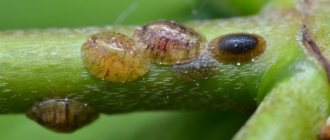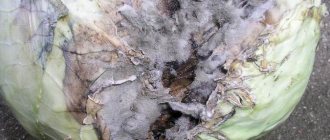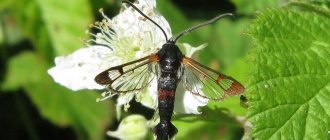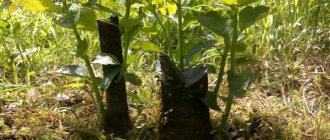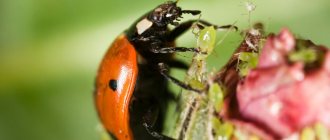Previously, it was believed that if a nematode was infested on a plot, then one could safely abandon it, sell it, build a house on it, or lay a road along this plot. People did not know how to get rid of the nematode and waited for years for it to die of starvation before planting an area that had previously been infested with the nematode. Introducing a nematode is as easy as shelling pears and there is no need to describe all sorts of methods: it is enough, for example, to buy a rose with a clod of soil, and the nematode is already on your site, period. But how to deal with it? We will talk about this in the article.
Nematode on cucumber roots. © Scot Nelson
Nematode biology
Nematodes are, according to some classifications, peculiar roundworms, and according to others, gastrociliary worms. More than three tens of thousands of species of these creatures have been described, but most likely there are much more. The overwhelming species of nematodes are parasites of a wide variety of plants; they can also live peacefully in the bodies of fish, humans and animals. Nematodes are far from harmless creatures; they cause a wide variety of diseases in humans, animals and plants.
The length of the nematode body can vary greatly (from 80 microns to several meters, if we mean certain types of parasites). Nematodes have a specific spindle-shaped shape, narrowed at the ends. The body is round in diameter.
Here we will talk about nematodes that parasitize plants, and we will try, in the light of modern science, to fight them so quickly that already in the next season after infection, something can be planted or sown on the site.
Let's start with the types of nematodes that plague plants. It is usually very difficult to understand that your area is infected with a nematode; there are few signs of its activity. For example, you see that seedlings are slow in development or there is almost no growth and development of seedlings, or flowering is weak, or the death of plants at a young age is suspiciously significant, or the crop is dying en masse.
All this can be either a sign of a nematode or a sign of other diseases or pests. The cause of unhealthy plants may also be a simple lack of one or a group of elements in the soil. Therefore, if exactly the same picture is observed next year, then we advise you to take a soil sample, dig it into a bag with a shovel and take it to the laboratory, where they will tell you whether it is a nematode or something else, otherwise you will continue to treat the plants for one thing or another , then from another, without getting the desired effect and simply massively multiplying the worst enemy.
Nematode under a microscope. © Håkan Kvarnström
How to get rid of nematodes - folk remedies
Not all gardeners, faced with a problem, rush to purchase chemicals. After all, they are aggressive not only for worms, but also for the plant, and even for human health. It is believed that with constant use, fruits, leaves, stems tend to accumulate the active substances of the drug. In this case, you can try folk remedies that destroy the parasite in the soil.
- Hot shower
Before planting, pour boiling water generously onto the soil to a depth of about 20 cm. Cover the top with plastic wrap, pressing down with a weight. It does not provide 100% relief from the nematode, since it can go even deeper.
- Potato sprouts
Grind 1 kg of potato sprouts, add a bucket of water and add 50 g of urea.
- Marigold
Grind 1 kg of fresh marigolds (flowers). Fill with a bucket of water. Leave for 2 days. Filter. Every other day, water the soil with the resulting infusion.
- Poisonous hogweed
Pour 1 kg of hogweed into a bucket of water. Leave in a warm place for a day. Mix. Filter.
- Calendula officinalis
Pour 1 tbsp. l. dried calendula flowers 1 liter of water. Leave it covered for a day. Water the infected plant every week.
- Onion
Grind 400 g of onions along with the husks, add a bucket of water. Leave for a day. Filter. Water the contaminated soil once a week.
How dangerous is a nematode?
In the process of its active life, it penetrates into the roots or vegetative mass, violates the integrity of the plant, causes rot, infection of the roots and vegetative mass with viruses, fungal infections, and bacteria.
In principle, it is possible to understand that a nematode has attacked the roots if the entire plant that has begun to wither is pulled out of the soil and its root system is carefully examined. When infected with a nematode, you can see a large number of branches on the roots, as if the plant was trying to find a way around it, getting rid of the pest.
In this case, the smallest roots will most likely look rotten. In addition, on the roots, if these are not legumes, you can see galls, these are literally accumulations of nematodes, cysts with eggs, as well as points and swellings, various kinds of ulcers - all this is deadly for both the root and the entire plant as a whole.
How to suspect the presence of pests in the soil
Nematodes can attack any plant; they can feed on tree sap. Currently, many breeders are breeding species that are resistant to worms. However, most plants do not have such immunity; gardeners have to deal with the scourge using various methods.
It is quite easy to suspect the presence of nematodes in any part of the plant; unpleasant signs are immediately noticeable:
- the plant stops developing, its growth is noticeably inhibited;
- new shoots appear later than expected, the plant blooms in small numbers;
- the shoots die, the remaining shoots lose their usual appearance;
- fruits appear in small quantities, often there is no harvest at all.
Nematodes that attack the root system of plants impair its nutrition. Violation of the integrity of the roots leads to an attack of the plant by various microorganisms: fungi, viruses, bacteria. A weakened plant is not able to resist diseases; wounds, bulges, and necrotic areas that have a yellowish color appear on its surface.
More about root nematode
So, a root nematode is, in fact, a filamentous worm belonging to a very large group of parasitic worms and a class of nematodes that form galls on the roots of plants, somewhat similar to those of legumes (only in such galls there are no nodule bacteria, and females, slaughtered with eggs).
Males of root nematodes have the appearance of a worm up to two millimeters long, females are more swollen (galls) or similar to egg capsules, half as long.
The ground nematode is surprisingly polyphagous: it is reliably known that it can infect the root system of more than two thousand plant species. Of course, this group includes cultivated vegetable plants, various valuable industrial crops, as well as ornamental plants, herbs, shrubs and even trees.
Depending on the temperature in the soil, it undergoes its full development into a real active organism within 20-50 days (when it is warmer, development usually occurs faster). It is noteworthy that a female nematode can lay a monstrous number of eggs in her life - up to two thousand, and according to the latest information - even more.
In each egg, the nematode larva first undergoes a molt, then comes to the surface and, thanks to the pointed ends, immediately penetrates the root of a nearby plant, beginning to intensively feed on the sap of this crop. She can either become an immobile female, who will subsequently lay an equally large number of eggs, or a male, who can move freely, looking for a female to fertilize.
Nematodes grow and develop most actively at moderate soil moisture (about 70-75%) and temperatures from +22 to +28°C. As for the acid-base balance, they prefer slightly slightly acidic soil, but not alkaline.
Root nematode in tomatoes. © Scot Nelson
Description of external signs of nematodes
Nematodes are worms one to two millimeters long. Female and male individuals differ in appearance from each other in their size. The first ones are slightly longer. The body shape of worms can be round, oval or oblong, resembling threads.
Nematodes in the soil (the fight against them can be very diverse) are white and beige. Worms have a well-developed muscular system and a protective shell that is highly dense. The head of the worms is very small and has movable lips, with the help of which the pests feed.
Nematodes reproduce by laying white eggs, which can be round or oval in shape. The larvae do not look like adults; they have a white head and a transparent body.
Nematodes, photos of which look very disgusting in the soil, have a well-developed sense of touch, due to the fact that their body is completely covered with tentacles. Pests prefer dry and warm microclimates, which are ideal for breeding and laying eggs.
Stem and leaf nematodes
In addition to soil nematodes, there are also leaf and stem nematodes. Most often, they lead to spindle-shaped thickening of the stems, while the leaves either underdevelop to normal size and shape, or severe deformation of the leaf blades occurs in a wide variety of plants.
Usually, dry necrotic spots of various shapes that have no pattern in location are more accurate evidence of the presence of a nematode on the leaves. Most often, leaf nematodes are infected with: garden strawberries, chrysanthemums and nephrolepsis. The stem nematode is not averse to eating vegetable crops, for example, garlic, onions, parsley, parsnips, radishes, tomatoes and cucumbers.
Let's look at the types of nematodes for the most important crops, and the first on this list will be table beets
Description of the pest
The size of the female can be from 0.2 to 2 mm, which will depend on the species and age of the individual. Males are somewhat different - their body is worm-shaped, narrowed in the front and somewhat rounded in the back. Length – from 0.5 to 2 mm. At the same time, females are motionless, and males have the ability to move.
The larvae of root-knot nematodes are similar in body structure to males. They also have a worm-like shape, but are smaller in size. The integument is dense, elastic, milky white in color, and with age they become transparent.
On a note! The body integument of the root-knot nematode is so strong that it can provide reliable protection from chemicals and exposure to an aggressive environment. This structural feature makes it quite difficult to fight parasites!
The eggs are microscopic in size. The female lays them in egg sacs, which consist of a gelatin-like film. At the same time, the number of eggs at a time can range from several hundred to a thousand.
It is the root-knot nematode that is often the main culprit in the early death of tomatoes and cucumbers growing in greenhouse conditions. In addition, it is very harmful to plants such as Turkish carnation and gerbera.
Beet nematode
It is interesting that previously the presence of nematodes on beets was not officially recognized and for some reason the disease was called beet fatigue: allegedly, when grown in the same place, even applying fertilizers did not help to obtain good results. But then everyone found out that the nematode also occurs on beets, and it is very rampant.
It is actually quite simple to understand that beets are infected with a nematode; for starters, you can see a clearly visible browning of its leaves, and if you pull out such a plant, you can see either a half-rotted (or slightly less) root crop, which can only be thrown away, because It cannot be recycled. Often, root vegetables can be whole, but they lose weight several times, and are absolutely not stored; they can only be used for processing. From a plantation infected with a nematode, no more than half of the table beet roots that have been deprived of their maximum weight can be harvested
How to prevent serious infection
As you know, it is almost impossible to completely destroy the root-knot nematode. For this reason, greenhouse growers are usually faced with the question of how to reduce the number of parasites to a safe limit and avoid large crop losses. Proper prevention will help here, which is based on:
- timely destruction of weeds;
- increased flow of the substrate in the greenhouse, which should alternate with its drying;
- placing manure in the soil;
- pouring the substrate twice with an infusion from the plant that is currently being processed, and alternating it with drying the soil;
- growing peas and beans, which are trap plants for root-knot nematodes, as well as watercress, which can sharply reduce the number of harmful individuals.
Nematode on potatoes
Another vegetable that is most often affected by nematodes is potatoes. It is extremely easy to infect your plot with this scourge; you just need to buy seed material once in an unverified place and you can give up on a good harvest for many years (or start using harsh chemicals). The fact is that even if you cut the purchased tuber, you may not notice the larva hiding in the potato at all, and only after it is placed in the soil will it come out in the form of a worm.
The potato nematode is a round worm, reaching approximately a millimeter in length, which can parasitize both the roots and tubers of potatoes. Usually, worms move into the tuber from the roots if the soil is poor in nutrition and the roots are very thin.
The life process of the potato nematode itself is very interesting. After the worms emerge from the tuber, the females attach to the end of the root and wait for the male, and the male, in search of the female, can move along the roots of the potato, causing harm to the plant, and when he finds the female, he dies after her fertilization. After this, the female actually dies too, she turns into a cocoon-cyst, in which up to a thousand individuals of different sexes are found in the form of eggs; they, naturally, remain in the soil after digging the potatoes.
Next spring, when the potatoes are planted in this place, the cysts rupture, the larvae come out and everything repeats again.
It is clear that the nematode greatly inhibits the development of potato plants, the yield drops significantly, and if the soils are poor, then the nematode simply does not allow the roots of the plants to absorb food, and no more than a couple of small tubers can be found in the holes.
Outwardly, you can see that the plants are much behind in growth from their counterparts; in warm weather they seem to curl, because the nematode does not allow them to absorb moisture from the soil, and if you pull the plant out of the soil, you can also find a huge number of thin roots unusual for potatoes.
In general, it would take a long time to describe different types of nematodes on different plants; it’s better to move on to a story about measures to combat this infection.
Potato nematode. © Graham Rawlings
Heat treatment
The thermal method will only help if there are not too many “invaders” on the roots. This method does not save severely damaged plants. The thermal method is recommended for use by lovers of indoor flowers. This is an excellent prevention of the appearance of nematodes on the roots of potted plants. Heat treatment should be carried out when flowers enter the dormant phase or when transplanting. The algorithm of actions is as follows.
- Heat the water to 50°C.
- Remove pest-affected specimens from the ground.
- Immerse the plants with their roots in previously heated water.
- With minimal damage to the root system, 5 minutes are allotted for the “bath”. If significant defects in the rhizome are visible, the “bathing” time is increased to 15 minutes.
- Immerse the plants in a container of cool water. Allow the roots to cool.
- Planted in a new substrate.
Another option for heat treatment is pouring boiling water over the soil. This procedure allows you to reduce the number of worm-like pests in your garden or flower bed. It is necessary to water the day before planting seedlings. To get the effect, it is important to saturate the soil with boiling water for at least 20 cm.
A useful life hack: to ensure that the soil cools down slowly after a spill, you need to cover the treated area with polyethylene. This will help increase the effectiveness of the procedure.
Measures to combat nematodes on the site
If a nematode somehow got into your area, then all you have to do is listen to the professionals, although many advise just waiting two or three years, keeping the plants under black fallow, digging up the area before winter with a clod of earth, without breaking the clods, and then you, maybe exterminate the nematode.
But if you want to get rid of it as soon as possible, then first try using crop rotation. That is, in the area where you noticed a beet nematode, do not plant any more beets, and if you notice a potato nematode, then plant potatoes. Perhaps in this way it will be possible to get rid of a certain type of nematode in your area.
After crop rotation, which is unlikely to help, heavier equipment is used, this is fumigation, which at the moment is the most effective means of combating the pest, but it is also harmful.
Mechanical method
You can get rid of root-knot nematode by digging up the infected plant and removing the root. The bush needs to be divided into several parts. If possible, it is worth leaving as many cuttings as possible. This determines how quickly the numbers of the infected variety can be restored in the future. The resulting cuttings are grown in a special way: each part is subject to strict quarantine. It lasts at least a year. A long quarantine is needed to prevent possible re-infection, because if the cuttings were initially carried out incorrectly, then the nematode larvae could remain on the plant.
The effectiveness of the mechanical method of controlling root pests is difficult to predict. Much depends on the plant itself, the degree of damage, the placement of the “clean” part relative to the colony, etc.
What is fumigation?
This is the treatment of soil that is definitely infected with a nematode (for which samples and tests are taken in advance) with various powerful poisons and even their vapors, sometimes in hot form. In principle, the pesticides themselves can now be bought even on the market; these are Nefamos, Dimethoate or Vidat.
These preparations can be used both to treat plants infected with nematodes and to shed them on the soil. These drugs are quite dangerous and we would not advise just pouring chemicals, but it is better to entrust this matter to professionals who can reliably treat the area and destroy not only adult nematode worms, which die almost immediately, but also much more tenacious larvae, which sometimes require several processing.
Next year, it is better to carry out only a control planting of plants in this area, occupying, say, a third of the area with a variety of crops and checking whether the nematode remains in the soil.
Drugs
Root-knot nematodes cannot be controlled with pesticides. The worm-like pest can withstand the effects of many of them. When choosing preparations for treatment, preference should be given to nematicides. Their main advantage is safety for humans. In addition, they ensure the preservation of the balance of fungi and bacteria in the soil. This allows you to resist future nematode attacks.
The active ingredient of such biological products is a predatory mushroom. But the drugs also have a significant disadvantage: although they prevent nematodes from multiplying, they do not save the affected plant. The following nematicides have proven themselves to be effective:
- Nematophagin BT. The drug is diluted in a ratio of 1:100. You can apply the product to the soil at the time of planting or two weeks before. The only difference is the amount of spillage: you need to read the instructions in detail. Treatment should be repeated after 14 days.
- Nematorin. This is a new generation nematicide. It is characterized by low toxicity. The effectiveness of the product does not depend on the acidity of the soil.
- Bassamil. The drug was created to protect the “favorites” of nematodes - cucumbers and tomatoes. You need to prepare the solution according to the instructions and pour it on the soil.
Traditional methods
Many generations of gardening enthusiasts have fought against root-knot nematodes. Naturally, a huge number of folk recipes have appeared on how to ward off the pest. The three most popular are presented below:
- Spilling "sugar" water. You need to dissolve regular sugar in running water and pour over the area where the damaged plants were found. Manipulation will help attract “helpers” - microorganisms that are enemies of root-knot nematodes. These include mites, predatory fungi, and predatory nematodes. They parasitize on the voracious larvae of the “invaders”.
- Planting the necessary plants. Marigolds and calendula repel root-knot nematodes. Therefore, it is recommended to plant these plants in the garden, especially in areas where cucumbers, tomatoes, and carrots are planted. It is these cultures that most often suffer from “invaders”.
- Herbal infusions. You can repel nematodes using calendula tincture. You will need a kilogram of flower raw materials. It is poured with boiling water (the volume is a full bucket). The product is infused for two days, and then used for watering vegetable crops. Infusions of nasturtium and onion peel are made in the same way.
Traditional methods help reduce the number of pests on the site. However, they are unable to breathe life into affected plants.
Drawing conclusions about the nematode
The nematode is a dangerous pest; you need to be careful when purchasing seed material, plants in closed ground, and even just seedlings with parts of the soil. It can be especially frustrating for owners of small plots, who will have to wait years before anything can be planted on them, or add liters of chemicals to fight a harmful infection without a guarantee that there is not a cyst with a couple of thousand eggs left somewhere.
Remember that the nematode is both an external and internal quarantine object. You cannot sell products that are infected with a nematode, and you cannot transplant plants to other areas from areas that are infected with a nematode. If potatoes are grown in an area infected with a nematode, then they can only be processed and, best of all, used as feed for farm animals.
If you have ever dealt with a nematode, describe your experience in the comments to the article, perhaps it will be very useful to some of the readers.
Prevention
To prevent infection of an area with a nematode, you must adhere to the following rules:
- After harvesting, carefully remove all plant debris, leaves and grass from the garden.
- Weed and loosen agricultural crops in a timely manner.
- If yellow leaves appear and stems change color, remove them from the area as soon as possible.
- Use proven planting material.
- Carry out deep digging of the soil in autumn and early spring.
- Avoid over-wetting the soil.
An important preventative measure is also the use of nematode-resistant varieties. Among tomatoes, these are Nagano F1, Evpator F1, Malika F1, potatoes - Diamant, Picasso, strawberries - Dessertnaya, Saxony.
Control measures
It is very difficult to get rid of this pest, and crops that are heavily infested with it are almost always thrown out or burned outside the dacha area. If the plant is slightly infected, it can still be saved. And at the same time, they carefully treat the contaminated soil. If the number of pests is small, then they start with folk recipes; in more severe cases, they move on to chemicals.
Mass reproduction of the pest begins when the air temperature remains at +20°C with a humidity of at least 50%. If the air temperature and humidity conditions are the same all summer, then about 3 generations of the nematode will grow.
Even if nothing grows on this land, she will still be able to live in it for several more years. Many gardeners, in order to avoid the massive spread of this pest, use crop rotation every three to four years. For example, a pest that fed on carrots last season will not be able to feed on onions in the same bed this season, since it is accustomed to that food. Then he dies.
Folk recipes
Traditional recipes are usually used only in mild cases of infection.
- Trimming the roots - If there are very few growths, then they can be trimmed, but you should not get too carried away with this, since the plant does not always have time to grow new roots. The edges are treated with a weak solution of potassium permanganate.
- Hot water - The water should not be higher than 50°C, otherwise the crop may cook. Infected greenery is pulled out along with the root system, washed to remove any adhering soil, and then briefly placed in a bucket of hot water. 20 minutes is enough for all adult parasites to die. But only hotter water can destroy eggs. In this case, you can take a risk and increase the water temperature to 60°C.
- Urea - Add 500 grams of urea and a kilogram of crushed potato sprouts to a ten-liter bucket of water. After that, the infected beds are watered with this product.
- Marigolds - A tincture is made from them that successfully gets rid of pests. About a kilogram of dried raw materials is soaked in a ten-liter bucket of liquid for about two days, then passed through a sieve and watered the soil.
- Poisonous hogweed - A tincture is also made from it, but the entire procedure is done with rubber protective gloves, since the juice of this plant is poisonous. About a kilogram of this herb is soaked in a bucket of liquid for exactly one day, after which it is filtered and watered.
- Calendula officinalis - This remedy is good because it can be used for both prevention and treatment purposes. You can water the soil with this tincture every week. To do this, stir ten tablespoons of dried herbs into a ten-liter bucket of liquid. Leave for exactly one day, then water. You don't have to strain it.
- Onion - To make the tincture, pour a pound of chopped onion into a bucket of liquid. The next day, pass through a sieve and water the beds every week. Three procedures are enough.
Chemicals
If folk remedies do not help get rid of the scourge, then you can use chemicals. The most effective and popular are:
- Vidat.
- Methyl bromide.
- Dimethoate
- Karbofos.
- Carbation.
- Lindan.
- Methyl mercaptophos.
- Nemagon.
- Nemafos.
- Rogor.
- Phosphamide.
- Chloropicrin.
They are used strictly according to the instructions, some of them can be reused after a few days. Some drugs can be used as a spray. This procedure is performed only in the evening and in calm weather. Unfortunately, most of these drugs cannot kill eggs due to their very tough shell. Therefore, it is recommended to repeat the treatment after some time, when the larvae hatch from the eggs.
Green manure
If you plant the entire soil with green manure, for example: beans, peas, beans, marigolds, clover, then they will be able to destroy about 85% of pests in a season. They need to be planted so that the distance between them is at least 4 centimeters.
Before this, the entire soil is cleared of plantings and weeds, and watered with the chemical drug “Narcissus”. After which green manure is sown. And the soil is covered with compost. As soon as the grass dries out, a new portion of green manure is replanted.
Next season, only nematode-resistant crops are grown in this place, since a certain percentage of parasites still remain in the soil. It is not recommended to grow cucumbers in such soil for about five years, as they are very easily captured by pests.
Vegetables grown in contaminated soil are not recommended to be propagated. And also they are not stored next to healthy ones. If possible, they are simply burned. For planting, specialized gardening stores purchase new planting material that is guaranteed not to be contaminated.
